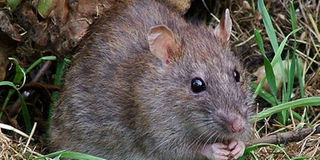Rodents huge threat to agriculture

Rodents such as this one cause millions of dollars in damage to crops.
What you need to know:
Scientists have studied that female rats enter into heat between about 10 and 24 hours after giving birth, which makes it possible for them to reproduce every month.
Did you know that there is a certain female rat species that can reproduce 48 young rats in two months?
Scientists have studied that female rats enter into heat between about 10 and 24 hours after giving birth, which makes it possible for them to reproduce every month.
“Scientifically, females go into heat on the first evening that is at least 10 hours after giving birth,” according to scientist Gilbert Challet in his study ‘An Urban Roof Rat Control Programme in Orange Country’ in 1985.
In 1988 it was found that female rats that conceive shortly after giving birth may go through an extended gestation of about 32 days rather than the normal 21 and 22 days.
“It looks like the female conceived about 10 days after giving birth, when in fact she conceived shortly after birth but simply has a longer pregnancy than normal,” researchers Menella and Moltz studied in 1988.
24 rats reproduced at once
Such a phenomenon of a female rat coming into heat shortly after giving birth is scientifically called postmortem estrus. Prof Loth Mulungu, an expert in rodent research from Sokoine University of Agriculture’s Pest Management Centre said there is a species of rats in Morogoro that can even reproduce 24 rats at once, if well fed with water and food.
Such scientific evidence of rats’ reproduction capacity have economic repercussions on the food security.
Herwig Leirs, Vicent Sluydts and Rhodes Makundi studied rodent outbreaks in sub-Saharan Africa and found that the outbreaks of mouse, rats and squirrels characterised by larger incisors used for gnawing or nibbling, were a major concern for agriculture in Africa especially in drier areas.
“High rat outbreak leads to high food damage before and after harvests,” said Prof Mulungu.
“The situation becomes worse in areas where farms are surrounded by forests. The more people open new farms by clearing forests the more disturbances they cause to rats and hence rats attack food in nearby farms.”
He had learnt that there are about 50 species of rats in sub-Saharan Africa and more than 30 eat crops, but with changes of climate, the scientist said, even the remaining 20 species might start eating crops which becomes a bigger threat to farmers.
In Tanzania, Prof Mulungu learnt the presence of such a rat in Morogoro, where it reproduces throughout the year. In 1989, Lindi experienced an outbreak of the multimammate mouse where rodent densities were estimated to be 1,400 rats per hectare, causing a yield loss of 48 per cent in maize fields.
“As the consequence of this outbreak, Tanzania had to supply food to residents threatened by famine,” noted the three researchers.
Sixteen rodent outbreaks were reported in Tanzania alone between 1925 and 2005.
In one of the studies, Prof Mulungu and his colleagues in 2002 found that in Morogoro, during the planting season, there was a rodent density of 40 multimammate mice per hectare, leading to the destruction of 80 per cent of maize seedlings.
Mwanampene Mgaya, a farmer, agrees that rats are causing a huge loss of crops.
“Farmers are aware of the destruction caused by rats but it is difficult to prevent it. We call on researchers to help us.” Scientists have learnt that rats can destroy between 6.1 and 11.2 per cent of rice during rainy and dry seasons. This is equivalent to between 0.19 and 0.48 tonnes per acre.
The Food and Agriculture Organisation (FAO) says rats can destroy between five and 15 per cent or 382,673 tonnes of crops annually. The amount is enough to feed 2.1 million annually in the country. This is when a person eats 0.5 kg a day which is FAO’s recommended amount.
Global issue
It is not only Tanzania that is facing the challenge as the issue has become global. In some countries, rats account for 100 per cent loss of crops.
Dr Adam John from the Agricultural and Food Policy Studies Institute of University of Putra Malaysia in Kuala Lumpur, has established that food losses due to rodents are staggering.
“In Asia alone, annual food losses due to rodents would be enough to feed 200 million people each year,” he noted. This is close to the population of Malaysia which is 252.8 million.
Pre-harvest losses
Dr John, who is also an expert on ecological-based rodent management said rice pre-harvest losses are estimated to be between five and 10 per cent in most Asian countries, however, in some countries it is expected to be significantly higher.
“In Indonesia yield loss estimates are around 19 per cent which is the equivalent of enough grain to feed 39 million Indonesians.
However, the destruction caused by rats on a localised level can be devastating where rodent outbreaks can wipe out entire harvests and lead to famine like conditions.”
Policymakers are doing everything possible to contain the challenge.
In Tanzania, the government is concerned with pests and has addressed the issue in the Plant Protection Act, 1997.
The Act defines ‘outbreak pests’ as harmful organisms to plants occurring in large numbers over large tracts of land, and in such magnitude that an individual or group of individual owners of occupiers cannot control or contain.
The issue is also being addressed in the national policy “Plant and Crop Protection Services Policy.” But scientists are of the views that the policy requires a highly organised research and an extension service, which to be effective, requires both national and international approaches.
Research on pests
The direct government intervention is required in some activities including research on pests which cause high losses in crops.
“Therefore, the SUA Pest Management Centre is addressing the research aspect of this policy, and the results are disseminated to the extension service for use by stakeholders,” noted Prof Mulungu.
According to the policy, technology for pest control must come from vigorous, aggressive and problem oriented research programmes.
It must also be accomplished through the effects of dedicated and competent scientific personnel working under a sound, well planned and organised research system.




